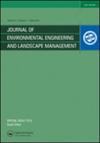TEMPORAL AND SPATIAL EVOLUTION CHARACTERISTICS OF LAND USE AND LANDSCAPE PATTERN IN KEY WETLAND AREAS OF THE WEST LIAO RIVER BASIN, NORTHEAST CHINA
IF 1.1
4区 环境科学与生态学
Q4 ENVIRONMENTAL SCIENCES
Journal of Environmental Engineering and Landscape Management
Pub Date : 2022-03-22
DOI:10.3846/jeelm.2022.16382
引用次数: 1
Abstract
The impact of the wetland ecosystem on arid and semi-arid areas is much higher than that in humid areas. It plays a more significant role in regulating climate, conserving water sources, purifying water bodies, and protecting biodiversity. The West Liao River Basin is located in a moderately temperate, semi-arid, and continental monsoon climatesensitive area, with a fragile ecological environment. Climate warming and drought have gradually caused dry-flow of some river sections in the basin, reduction in the water area, shrinking of wetlands, degradation of vegetation ecological function, and decline of biodiversity. Ultimately, the effect of ecological barriers is significantly weakened. The research of the temporal and spatial evolution of landscape patterns and their relationship with human activities in arid and semi-arid regions is of great significance for the protection and restoration of wetland resources. Based on Landsat remote sensing images in 1985 and 2015, the temporal and spatial evolution of landscape patterns in four key wetland areas in the West Liao River Basin was studied by 3S technology and landscape ecology indexes. Results show that during the 30a years, the wetland resources area in the West Liao River Basin is drastically reduced. Wetland resources of the four study areas, the Dalinor, the Saihanwula, the Hongshan Reservoir, and the West Liao River Estuary, were decreased by 13.80%, 31.06%, 61.10%, and 66.03%, respectively. The reduced wetland resources in the Dalinor and the Saihanwula were mainly converted into grassland, while those of the Hongshan Reservoir and the West Liao River Estuary were mostly converted into farmland. The diversity and evenness indexes of landscape in the Hongshan Reservoir and the West Liao River Estuary are gradually decreasing. The diversity and evenness indexes of the Dalinor and the Saihanwula are not significantly changed but are slightly disturbed by human activities. Changes in the landscape pattern index highlight the decrease in the water area, the increase in the area of dry and paddy fields, and the improvement of sandy land. All these further reflect that insufficient water resources supplementation and increasing human disturbance have a profound impact on the landscape pattern, which has also become the main driving force for the evolution of the landscape pattern in the West Liao River Basin.辽河流域西部重点湿地土地利用与景观格局时空演化特征
湿地生态系统对干旱半干旱区的影响远大于湿润地区。在调节气候、涵养水源、净化水体、保护生物多样性等方面发挥着更为重要的作用。西辽河流域地处中温带半干旱大陆性季风气候敏感区,生态环境脆弱。气候变暖和干旱逐渐造成流域部分河段干流,水域面积减少,湿地萎缩,植被生态功能退化,生物多样性下降。最终,生态屏障的作用明显减弱。研究干旱半干旱区景观格局的时空演变及其与人类活动的关系,对湿地资源的保护与恢复具有重要意义。基于1985年和2015年的Landsat遥感影像,采用3S技术和景观生态指数对西辽河流域4个重点湿地景观格局的时空演变进行了研究。结果表明:近30a来,西辽河流域湿地资源面积急剧减少;大力诺、赛汉乌拉、红山水库和西辽河河口4个研究区湿地资源分别减少13.80%、31.06%、61.10%和66.03%。大里诺河和塞罕乌拉湿地资源减少主要为草地,红山水库和西辽河河口湿地资源减少主要为农田。红山水库和西辽河河口景观多样性和均匀度指数呈逐渐下降趋势。达里诺河和赛罕乌拉河的多样性和均匀度指数没有明显变化,但受到人类活动的轻微干扰。景观格局指数的变化表现为水域面积减少,旱地和水田面积增加,沙地面积改善。这些都进一步反映了水资源补充不足和人为干扰加剧对景观格局的深刻影响,这也成为西辽河流域景观格局演变的主要驱动力。
本文章由计算机程序翻译,如有差异,请以英文原文为准。
求助全文
约1分钟内获得全文
求助全文
来源期刊
CiteScore
1.90
自引率
7.70%
发文量
41
审稿时长
>12 weeks
期刊介绍:
The Journal of Environmental Engineering and Landscape Management publishes original research about the environment with emphasis on sustainability.

 求助内容:
求助内容: 应助结果提醒方式:
应助结果提醒方式:


